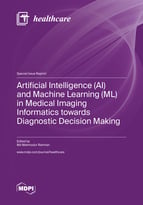Artificial Intelligence (AI) and Machine Learning (ML) in Medical Imaging Informatics towards Diagnostic Decision Making
A special issue of Healthcare (ISSN 2227-9032). This special issue belongs to the section "Artificial Intelligence in Medicine".
Deadline for manuscript submissions: closed (31 May 2023) | Viewed by 35461
Special Issue Editor
Interests: computer vision; image processing; information retrieval; machine learning; deep learning; classification, retrieval and interpretation of medical images; medical caption generation; explainable AI
Special Issues, Collections and Topics in MDPI journals
Special Issue Information
Dear Colleagues,
Medical imaging informatics and image-based medical diagnosis is one of the important service areas in the healthcare sector. A large number of medical images of various modalities (CT, MRI, X-ray, ultrasound, etc.) are generated by hospitals and clinics every day. Such images constitute an important source of anatomical and functional information for diagnosis of diseases, medical research, and education. According to the Society for Imaging Informatics in Medicine (SIIM), “Imaging informatics touches every aspect of the imaging chain from image creation and acquisition to image distribution and management, to image storage and retrieval, to image processing, analysis and understanding, to image visualization and data navigation, to image interpretation, reporting, and communications. The field serves as the integrative catalyst for these processes and forms a bridge with imaging and other medical disciplines.”
It has emerged as one of the fastest growing research areas in recent years given the evolution of techniques in radiology, molecular imaging, anatomical imaging, and functional imaging and advancements in imaging biomarker generation. Especially, for the past decade, research in this field has increasingly been dominated by Artificial Intelligence (AI) and Machine Learning (ML). Currently, substantial efforts are developed for the enrichment of medical imaging applications using Deep Learning (DL) for detection, segmentation, diagnosis, annotation, summarization and prediction.
This Special Issue (SI), invites manuscripts (research, review, and case studies) on AI and ML (especially DL techniques) based ongoing progress and related development in medical imaging informatics to influence human health and healthcare systems through diagnostic decision making process. The SI will cover topics across the spectrum of medical imaging informatics by considering the breadth of imaging modalities (e.g., optical, molecular, in addition to traditional diagnostic modalities) and the diversity of specialties that depend on imaging information (e.g., radiology, dermatology, pathology, surgery, etc.).
Research areas may include (but not limited to) the following:
- AI/ML-based classification, object (concept) detection in medical imaging;
- Pattern recognition and reasoning for the specific disease in medical imaging;
- AI/ML based disease detection and diagnosis;
- ML/DL in radiology;
- Skin cancer diagnosis in dermoscopic images;
- AI/ML in Oncology;
- AI Based analysis of histopathological images;
- Retinal imaging and image analysis;
- AI-based peripheral blood smear image analysis;
- Application of ML in multimodal medical data;
- AI/ML-based decision support systems (DSSs);
- AI/ML-based screening systems;
- DL-based biomedical medical image classification;
- Multi-class and multi-label classification of biomedical images;
- ML/DL-based biomedical image retrieval systems;
- DL-based automatic medical image annotation and summarization;
- Explainable AI in medical imaging and DSS;
- Addressing bias in biomedical image data and imaging informatics.
Dr. Md Mahmudur Rahmanon
Guest Editor
Manuscript Submission Information
Manuscripts should be submitted online at www.mdpi.com by registering and logging in to this website. Once you are registered, click here to go to the submission form. Manuscripts can be submitted until the deadline. All submissions that pass pre-check are peer-reviewed. Accepted papers will be published continuously in the journal (as soon as accepted) and will be listed together on the special issue website. Research articles, review articles as well as short communications are invited. For planned papers, a title and short abstract (about 100 words) can be sent to the Editorial Office for announcement on this website.
Submitted manuscripts should not have been published previously, nor be under consideration for publication elsewhere (except conference proceedings papers). All manuscripts are thoroughly refereed through a single-blind peer-review process. A guide for authors and other relevant information for submission of manuscripts is available on the Instructions for Authors page. Healthcare is an international peer-reviewed open access semimonthly journal published by MDPI.
Please visit the Instructions for Authors page before submitting a manuscript. The Article Processing Charge (APC) for publication in this open access journal is 2700 CHF (Swiss Francs). Submitted papers should be well formatted and use good English. Authors may use MDPI's English editing service prior to publication or during author revisions.
Keywords
- medical imaging
- medical imaging informatics
- decision support system
- diagnostic aid
- computer aided diagnostic (CAD) systems
- AI-based screening system
- medical image classification
- biomedical image retrieval
- medical image annotation
- biomedical image summarization







